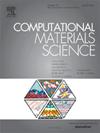Hybrid density functional studies of intrinsic defects in Zn2SbN3 for potential solar cell application
IF 3.1
3区 材料科学
Q2 MATERIALS SCIENCE, MULTIDISCIPLINARY
引用次数: 0
Abstract
Zn2SbN3 semiconductors with defect-tolerant properties have a simple structure and promise to be useful in a variety of solar energy conversion applications. The calculated results indicate that Zn2SbN3 has a band gap of 1.55 eV, which corresponds to the optimal solar energy absorption band gap. In the visible light range, its absorption coefficient can reach up to 104–105 cm−1, which makes it a suitable material for solar photovoltaic applications. Hybrid functional calculations are used to investigate electronic and defect properties. Our research indicates that SbZn, Zni, and VN1 are the most dominant native defects with low formation energy, which means that the experiment is associated with high resistivity. VN1 has multiple localized defect states in the band gap that play a significant role in photovoltaic properties and can capture free carriers. This study provides a detailed theoretical explanation of the main reason for the inefficiency of nitride semiconductors as solar cell materials. Also, this is a comprehensive theoretical reference that can be used to grow high-quality thin films and other nitride semiconductor solar cells in experiments.

Zn2SbN3本征缺陷的杂化密度泛函研究及其在太阳能电池中的潜在应用
具有耐缺陷性能的Zn2SbN3半导体结构简单,有望在各种太阳能转换应用中发挥作用。计算结果表明,Zn2SbN3的带隙为1.55 eV,对应于最佳的太阳能吸收带隙。在可见光范围内,其吸收系数可达104-105 cm−1,是太阳能光伏应用的合适材料。混合泛函计算用于研究电子和缺陷性质。研究表明,SbZn、Zni和VN1是最主要的天然缺陷,具有较低的地层能量,这意味着该实验与高电阻率有关。VN1在带隙中具有多个局部缺陷态,这些缺陷态对光伏性能起着重要作用,并且可以捕获自由载流子。本研究为氮化半导体作为太阳能电池材料效率低下的主要原因提供了详细的理论解释。同时也为实验中生长高质量薄膜及其他氮化半导体太阳能电池提供了全面的理论参考。
本文章由计算机程序翻译,如有差异,请以英文原文为准。
求助全文
约1分钟内获得全文
求助全文
来源期刊

Computational Materials Science
工程技术-材料科学:综合
CiteScore
6.50
自引率
6.10%
发文量
665
审稿时长
26 days
期刊介绍:
The goal of Computational Materials Science is to report on results that provide new or unique insights into, or significantly expand our understanding of, the properties of materials or phenomena associated with their design, synthesis, processing, characterization, and utilization. To be relevant to the journal, the results should be applied or applicable to specific material systems that are discussed within the submission.
 求助内容:
求助内容: 应助结果提醒方式:
应助结果提醒方式:


